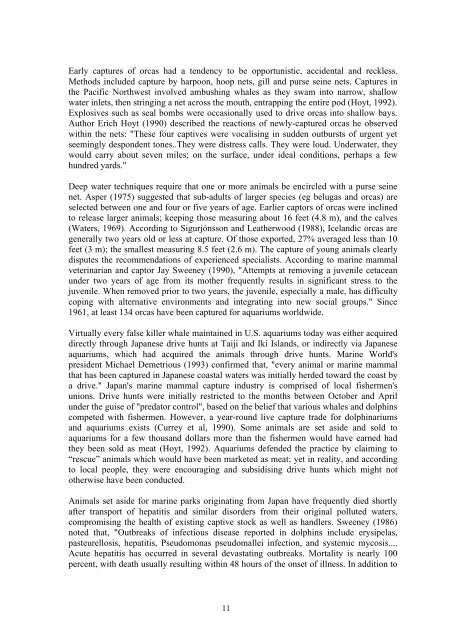Captive Cetaceans: A Handbook for Campaigners - Whale and ...
Captive Cetaceans: A Handbook for Campaigners - Whale and ...
Captive Cetaceans: A Handbook for Campaigners - Whale and ...
Create successful ePaper yourself
Turn your PDF publications into a flip-book with our unique Google optimized e-Paper software.
Early captures of orcas had a tendency to be opportunistic, accidental <strong>and</strong> reckless.<br />
Methods included capture by harpoon, hoop nets, gill <strong>and</strong> purse seine nets. Captures in<br />
the Pacific Northwest involved ambushing whales as they swam into narrow, shallow<br />
water inlets, then stringing a net across the mouth, entrapping the entire pod (Hoyt, 1992).<br />
Explosives such as seal bombs were occasionally used to drive orcas into shallow bays.<br />
Author Erich Hoyt (1990) described the reactions of newly-captured orcas he observed<br />
within the nets: "These four captives were vocalising in sudden outbursts of urgent yet<br />
seemingly despondent tones..They were distress calls. They were loud. Underwater, they<br />
would carry about seven miles; on the surface, under ideal conditions, perhaps a few<br />
hundred yards."<br />
Deep water techniques require that one or more animals be encircled with a purse seine<br />
net. Asper (1975) suggested that sub-adults of larger species (eg belugas <strong>and</strong> orcas) are<br />
selected between one <strong>and</strong> four or five years of age. Earlier captors of orcas were inclined<br />
to release larger animals; keeping those measuring about 16 feet (4.8 m), <strong>and</strong> the calves<br />
(Waters, 1969). According to Sigurjónsson <strong>and</strong> Leatherwood (1988), Icel<strong>and</strong>ic orcas are<br />
generally two years old or less at capture. Of those exported, 27% averaged less than 10<br />
feet (3 m); the smallest measuring 8.5 feet (2.6 m). The capture of young animals clearly<br />
disputes the recommendations of experienced specialists. According to marine mammal<br />
veterinarian <strong>and</strong> captor Jay Sweeney (1990), "Attempts at removing a juvenile cetacean<br />
under two years of age from its mother frequently results in significant stress to the<br />
juvenile. When removed prior to two years, the juvenile, especially a male, has difficulty<br />
coping with alternative environments <strong>and</strong> integrating into new social groups." Since<br />
1961, at least 134 orcas have been captured <strong>for</strong> aquariums worldwide.<br />
Virtually every false killer whale maintained in U.S. aquariums today was either acquired<br />
directly through Japanese drive hunts at Taiji <strong>and</strong> Iki Isl<strong>and</strong>s, or indirectly via Japanese<br />
aquariums, which had acquired the animals through drive hunts. Marine World's<br />
president Michael Demetrious (1993) confirmed that, "every animal or marine mammal<br />
that has been captured in Japanese coastal waters was initially herded toward the coast by<br />
a drive." Japan's marine mammal capture industry is comprised of local fishermen's<br />
unions. Drive hunts were initially restricted to the months between October <strong>and</strong> April<br />
under the guise of "predator control", based on the belief that various whales <strong>and</strong> dolphins<br />
competed with fishermen. However, a year-round live capture trade <strong>for</strong> dolphinariums<br />
<strong>and</strong> aquariums exists (Currey et al, 1990). Some animals are set aside <strong>and</strong> sold to<br />
aquariums <strong>for</strong> a few thous<strong>and</strong> dollars more than the fishermen would have earned had<br />
they been sold as meat (Hoyt, 1992). Aquariums defended the practice by claiming to<br />
“rescue” animals which would have been marketed as meat; yet in reality, <strong>and</strong> according<br />
to local people, they were encouraging <strong>and</strong> subsidising drive hunts which might not<br />
otherwise have been conducted.<br />
Animals set aside <strong>for</strong> marine parks originating from Japan have frequently died shortly<br />
after transport of hepatitis <strong>and</strong> similar disorders from their original polluted waters,<br />
compromising the health of existing captive stock as well as h<strong>and</strong>lers. Sweeney (1986)<br />
noted that, "Outbreaks of infectious disease reported in dolphins include erysipelas,<br />
pasteurellosis, hepatitis, Pseudomonas pseudomallei infection, <strong>and</strong> systemic mycosis....<br />
Acute hepatitis has occurred in several devastating outbreaks. Mortality is nearly 100<br />
percent, with death usually resulting within 48 hours of the onset of illness. In addition to<br />
11

















